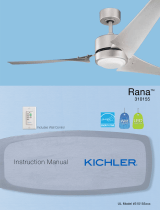
AVERTISSEMENT
AFIN DE RÉDUIRE LES RISQUES DE BLESSURE, NE PAS PLIER LES BRAS
DES PALES (AUSSI APPELÉS SUPPORTS) PENDANT OU APRÈS
L’INSTALLATION. NE PAS INSÉRER D’OBJETS DANS
LA TRAJECTOIRE DES PALES.
AVERTISSEMENT
AFIN DE RÉDUIRE LES RISQUES D’INCENDIE, DE CHOC ÉLECTRIQUE
OU DE BLESSURE, INSTALLER À UNE BOÎTE DE SORTIE DE COURANT
PORTANT LA MENTION ACCEPTABLE POUR LE SUPPORT DE VENTILATEUR.
1.
Règles de sécurité
REMARQUE
LIRE ET CONSERVER TOUTES LES INSTRUCTIONS!
1. Afin de réduire les risques de choc électrique, vous assurer que l’électricité a été
coupée au disjoncteur ou au coffret à fusibles avant de commencer.
2. Tout le câblage doit être conforme aux codes de l’électricité national et local.
L’installation électrique doit être effectuée par un électricien agréé qualifié.
3. AVERTISSEMENT : Afin de réduire les risques de choc électrique et d’incendie,
ne pas utiliser ce ventilateur avec un dispositif de contrôle de la vitesse à
semi-conducteur.
4. AVERTISSEMENT : Afin de réduire les risques d’incendie, de choc électrique
ou de blessure, installer à une boîte de sortie de courant portant la mention
« Acceptable pour le support d’un ventilateur de 15,9 kg (35 lb) ou moins »
et utiliser les vis de montage fournies avec la boîte de sortie de courant. La plupart
des boîtes de sortie de courant couramment utilisées pour le support de luminaires
ne sont pas acceptables pour le support d’un ventilateur et peuvent avoir besoin
d’être remplacées. Compte tenu de la complexité de l’installation de ce ventilateur,
il est fortement recommandé de faire appel à un électricien agréé qualifié.
5. La boîte de sortie de courant et la structure de support doivent être solidement
installées et en mesure de supporter de manière fiable un poids de 15,9 kg (35 lb)
ou moins. N’utiliser que des boîtes de sortie homologuées cUL et portant la
mention POUR SUPPORT DE VENTILATEUR.
6. Le ventilateur doit être installé en prévoyant un dégagement minimal de 3.05 m
(10 pi) entre le bas de la grille de protection du ventilateur et le plancher.
7. Éviter de placer des objets dans la trajectoire des pales.
8. Pour éviter les blessures ou les dommages au ventilateur ou à d’autres articles,
faire preuve de prudence en travaillant à proximité du ventilateur ou en
le nettoyant.
9. Ne pas utiliser d’eau ou de détergent pour nettoyer le ventilateur ou les pales du
ventilateur. Un linge sec ou légèrement humide convient la plupart du temps.
10. Une fois les branchements électriques réalisés, les conducteurs épissés doivent
être tournés vers le haut et poussés délicatement dans la boîte de sortie
de courant. Les fils doivent être écartés de façon que le conducteur mis à la
terre et le conducteur de mise à la terre de l’équipement soient placés du même
côté de la boîte de sortie de courant.
11. Les schémas électriques sont à titre de référence uniquement. Les luminaires
qui ne sont pas emballés avec le ventilateur doivent être homologués cUL et
porter une mention indiquant qu’ils conviennent au modèle de ventilateur que
vous installez. Les interrupteurs doivent être homologués cUL pour usage
général. Vous reporter aux instructions qui accompagnent les luminaires.





























